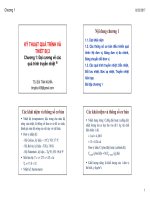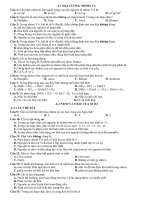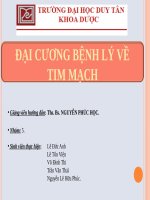Đại cương về lãnh đạo trong tổ chức chapter 2 leadership treats and ethics
Bạn đang xem bản rút gọn của tài liệu. Xem và tải ngay bản đầy đủ của tài liệu tại đây (585.12 KB, 44 trang )
.c
om
th
an
co
ng
Chapter 2
cu
u
du
o
ng
Leadership Traits
and Ethics
Copyright © 2010 by South-Western/Cengage Learning
All rights reserved.
CuuDuongThanCong.com
PowerPoint Presentation by Rhonda S. Palladi
Georgia State University
/>
ng
co
an
th
ng
du
o
u
List the benefits of classifying personality traits.
Describe the Big Five personality dimensions.
Explain the universality of traits of effective leaders.
Discuss why the trait of dominance is so important for
managers to have.
State how the Achievement Motivation Theory and the
Leader Motive Profile are related and different.
Identify similarities and differences among Theory X and
Theory Y, the Pygmalion Effect, and self-concept.
Describe how attitudes are used to develop four leadership
styles.
Compare the three levels of moral development.
Explain the stakeholder approach to ethics.
Define the key terms listed at the end of the chapter.
2
cu
.c
om
Chapter 2
Learning Outcomes
CuuDuongThanCong.com
/>
.c
om
Traits and Personality
Traits
ng
Are distinguishing personal characteristics
co
Personality
cu
u
du
o
ng
th
an
Is a combination of traits that classifies an
individual’s behavior
3
CuuDuongThanCong.com
/>
.c
om
What Value Do Traits and Personality Have
in the Study of Leadership?
cu
u
du
o
ng
th
an
co
ng
Understanding people’s personalities is
important because personality affects
behavior as well as perceptions and
attitudes
Knowing personalities help to explain and
predict others’ behavior and job
performance
4
CuuDuongThanCong.com
/>
.c
om
The Big Five Model of Personality
an
co
ng
Surgency
Adjustment
du
o
ng
th
Agreeableness
cu
u
Conscientiousness
Openness to
experience
Source: Adapted from T. A. Judge, D. Heller, and M. K. Mount. “Five-Factor Model of Personality and Job Satisfaction:
A Meta-Analysis.” Journal of Applied Psychology 87 (June 2002), 530(12).
5
CuuDuongThanCong.com
/>
Surgency (dominance)
.c
om
The Big Five
co
ng
Leadership and extraversion traits
Want to be in charge
th
an
Agreeableness
du
o
ng
Traits related to getting along with people
Sociable, friendly
u
Adjustment
cu
Traits related to emotional stability
– Stable = self-control, calm, good under pressure,
relaxed, secure, and positive
6
CuuDuongThanCong.com
/>
.c
om
The Big Five (cont.)
Conscientiousness
co
ng
Traits related to achievement
Responsible and dependable
th
an
Openness to experience
cu
u
du
o
ng
Traits related to the willingness to try new
things
Seek change
7
CuuDuongThanCong.com
/>
.c
om
Personality Profiles
Identify individual stronger and weaker
traits
Are used to ensure a proper match
between the worker and the job
Are also used to categorize people as a
means of predicting job success
cu
u
du
o
ng
th
an
co
ng
8
CuuDuongThanCong.com
/>
.c
om
Why Executives Are Derailed
cu
u
du
o
ng
th
an
co
ng
Used a bullying style viewed as intimidating,
insensitive, and abrasive
Were viewed as being cold, aloof, and arrogant
Betrayed personal trust
Were self-centered and viewed as overly
ambitious and thinking of the next job
Had specific performance problems with the
business
Overmanaged and were unable to delegate or
build a team
9
CuuDuongThanCong.com
/>
.c
om
Traits of Effective Leaders
Internal locus
of control
co
ng
Integrity
an
High energy
du
o
Sensitivity
to others
cu
u
Dominance
ng
th
Traits of
Effective
Leaders
Flexibility
Intelligence
Self-confidence
Stability
10
CuuDuongThanCong.com
/>
.c
om
Traits of Effective Leaders (cont.)
Dominance
th
ng
High energy
an
co
ng
Want to be in charge
Not overly bossy or bullying
Affects all other traits
u
du
o
Drive, hard work, stamina, persistence
Tolerate stress well
cu
Self-confidence
Trust own judgments, decisions, ideas,
capabilities
Related to effectiveness and advancement
CuuDuongThanCong.com
/>
11
.c
om
Traits of Effective Leaders (cont.)
Locus of control
an
co
ng
Internal = belief in the control of your own
destiny
External = belief in fate, luck, etc.
ng
th
Stability
cu
u
du
o
Emotionally in control, secure, positive
Associated with managerial effectiveness and
advancement
Integrity
Honest, ethical, trustworthy
Essential to running a successful business
CuuDuongThanCong.com
/>
12
.c
om
Traits of Effective Leaders (cont.)
Intelligence
th
– Self-awareness
an
co
ng
Is the ability to think critically, solve problems, and
make decisions
Is the best predictor of job performance
Emotional intelligence
du
o
ng
Being conscious of your own emotions and how they affect
your personal and professional life
– Social awareness
u
The ability to understand others
cu
– Self-management
The ability to control disruptive emotions
– Relationship management
The ability to work well with others
13
CuuDuongThanCong.com
/>
.c
om
Traits of Effective Leaders (cont.)
Flexibility
co
ng
Change, adjust to changes
The ability to influence others about change
th
an
Sensitivity
cu
u
du
o
ng
Understand group members as individuals,
communicate well, people centered
Requires empathy
14
CuuDuongThanCong.com
/>
.c
om
Achievement Motivation Theory
cu
u
du
o
ng
th
an
co
ng
Attempts to explain and predict behavior
and performance based on a person’s
need for achievement, power, and
affiliation
15
CuuDuongThanCong.com
/>
an
co
ng
Internal locus of control
Self-confidence
High energy
Goal oriented
ng
Realistic goals
th
.c
om
Characteristics of the
Need for Achievement (n Ach)
cu
u
du
o
Moderate risks
Competitive
16
CuuDuongThanCong.com
/>
u
du
o
ng
th
an
co
ng
Want to be in charge (in authority)
Self-confident
High energy
Competitive
Ambitious
Less concerned with people
cu
.c
om
Characteristics of the
Need for Power (n Pow)
17
CuuDuongThanCong.com
/>
.c
om
Characteristics of the
Need for Affiliation (n Aff)
Strong personal relationships
Sensitivity to others
Joiners
Prefer “helping professions”
Concerned about what people think of
them
Usually have low need for power
cu
u
du
o
ng
th
an
co
ng
Avoid leadership
18
CuuDuongThanCong.com
/>
.c
om
Leader Motive Profile (LMP)
du
o
ng
th
an
co
ng
Is a set of traits that match up to the
“typical” effective leader
Tends to have a high need for socialized
power, a moderate need for
achievement, and a lesser need for
affiliation
Socialized power
cu
u
– Used for the good of one’s self, the group, and the
organization
Personalized power
– Used for personal gain at the expense of others
19
CuuDuongThanCong.com
/>
.c
om
Combined Traits and Needs
The Big Five
Model of
Personality
co
ng
Nine Traits of
Effective Leaders
Achievement
Motivation Theory
and LMP
Domination
Agreeableness
Sensitivity to others
Adjustment
Stability
Socialized power
(LMP)
Conscientiousness
High energy
Self-confidence
Integrity
Need for
achievement
Internal locus of control
Intelligence
Flexibility
No separate need;
included within other
needs
Need for power
Need for affiliation
Openness to
experience
cu
u
du
o
ng
th
an
Surgency
20
CuuDuongThanCong.com
/>
.c
om
Leadership Attitudes
cu
u
du
o
ng
th
an
co
ng
Are positive or negative feelings about
people, things, and issues
Job attitudes and performance are
perhaps the two most central sets of
constructs in individual-level
organizational analysis research
21
CuuDuongThanCong.com
/>
Theory X and Theory Y
.c
om
Leadership Attitudes (cont.)
th
Pygmalion effect
an
co
ng
Attempt to explain and predict leadership
behavior and performance based on the
leader’s attitude about followers
cu
u
du
o
ng
Proposes that leaders’ attitudes toward and
expectations of followers, and their
treatment of them, explain and predict
followers’ behavior and performance
Self-concept
Refers to the positive or negative attitudes
people have about themselves
CuuDuongThanCong.com
/>
22
an
co
ng
Theory Y Attitude:
Employees like to work
Employees do not need
to be closely supervised
Managers display more
participative leadership
Managers use internal
motivation and rewards
cu
u
du
o
ng
th
Theory X Attitude:
Employees dislike work
Employees must be
closely supervised
Managers display more
coercive, autocratic
leadership
Managers use external
means of control, such
as threats and
punishment
.c
om
Theory X versus Theory Y
23
CuuDuongThanCong.com
/>
ng
.c
om
Discussion Question #1
cu
u
du
o
ng
th
an
co
McGregor published Theory X and
Theory Y over 30 years ago. Do
we still have Theory X managers?
Why?
24
CuuDuongThanCong.com
/>
.c
om
The Pygmalion Effect
cu
u
du
o
ng
th
an
co
ng
Proposes that the leaders' attitudes
toward and expectations of followers,
and their treatment of them, explain and
predict followers' behavior and
performance
In other words:
“If you think you can,
you can;
if you think you can’t,
you can’t.”
25
CuuDuongThanCong.com
/>









